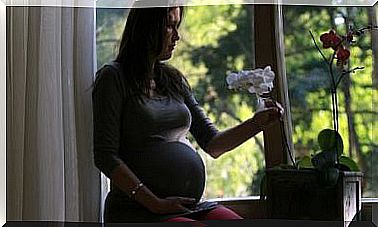Pelvis Pain During Pregnancy

Pelvis pain during pregnancy is one of the most common manifestations that appear during the pregnancy process. It is also known as pubic symphysis dysfunction.
Although it can appear at any time during pregnancy, its incidence is usually more common in the third trimester of pregnancy, a phase in which the body begins to prepare itself for the moment of delivery.
In this article, we will explain why pelvis pain during pregnancy appears. And we’ll also give you some advice that will help you prevent or alleviate the feelings of discomfort that this condition causes.
What causes pelvis pain during pregnancy?
Although the body always prepares itself naturally for the upcoming birth, this is not always the only cause that determines the onset or intensity of pain. Many factors can trigger pelvic pain during pregnancy and, depending on the factors, the intensity will vary.
To understand how other factors can play a role in the onset of pelvic pain during pregnancy, you must first know that the pelvis is made up of two parts, which are connected through a joint called the symphysis pubis.
Well, when childbirth approaches, in the last months of pregnancy, the body releases in the pelvic region a hormone known as relaxin, whose function is to soften the ligaments in that region.
In addition, it has an effect that gives more elasticity to the pubic symphysis, causing the pelvic bones to separate more to allow the passage of the baby during delivery.

If the separation of the bones in the pelvis is large, it can develop into pubic symphysis dysfunction. This condition does not only depend on the degree of separation of the mentioned bones. It also depends on other factors, both related to the pregnancy and pre-existing it.
Some Common Factors That Intensify Pelvis Pain During Pregnancy
the size of the belly
Whether it’s baby size, twin pregnancy, or just a natural disposition, some women experience more than average belly bulge during pregnancy.
With the progress of the pregnancy and the consequent increase in the belly, this makes the pelvis start to feel more and more the weight it supports, which, depending on the degree, can increase the pain.
preexisting overweight
Pelvis pain during pregnancy can also appear due to preexisting overweight at the beginning of pregnancy.
This can accentuate the weight that the pelvis receives and make that, even without feeling a distension of the pelvic symphysis, the weight itself generates pubalgia (hernia in the pubis) that causes pain in this region.
daily effort
The daily muscular effort performed by pregnant women can also, without presenting many previous symptoms, cause pubalgia.
musculoskeletal disorders
Musculoskeletal diseases can cause inflammation in the area of the pelvis or even weaken the bones or ligaments that support the belly to a greater or lesser degree, causing pain in the pelvis during pregnancy.
Pelvis pain during pregnancy is usually not due to a single cause, especially if it is severe pain. This is the result of both an excess in the separation of the pelvic bones and a combination of other factors that directly or indirectly put more pressure on or cause more sensitivity in this area.
Advice to relieve or prevent pain in the pelvis during pregnancy
- Pelvic brace. Wearing a pelvic brace can help put less pressure on this area, alleviating pain and making daily activities easier for pregnant women. If used early in pregnancy, it can help prevent pelvic pain caused by being overweight.

- Exercise the pelvic region. There are exercises aimed at exercising the pelvis during pregnancy in order to make childbirth easier and less painful. These exercises allow you to strengthen the pubic symphysis ligaments, in order to acquire better flexibility when stretching during pregnancy.
- Hydrotherapy. It allows you to strengthen your pelvis muscles during pregnancy and is especially helpful when pain is already present. This type of therapy relieves the joints in the pelvis and back and helps to strengthen the joints in these areas thanks to the resistance that the muscles generate when moving in water.
- Take special measures during pregnancy. It is redundant to say that heavy exercise should be avoided during pregnancy. In addition, to prevent pain in the pelvis , other measures are needed, including maintaining proper posture, avoiding the use of high heels, and minimizing tasks that involve carrying weights or squatting.
- Analgesics. The use of analgesics to relieve pelvic pain during pregnancy is an emergency or last resort option, especially recommended for when the pain is very severe or when it significantly interferes with daily activities.
General considerations
Especially if the pregnant woman is already in the third trimester of pregnancy, it is recommended that, when performing any exercise for the pelvis, she directly follow the instructions of a professional physiotherapist.
This is to avoid possible injury or incorrect exercise, which can aggravate the present or future pelvic pain situation .
At the same time, it is important that any pain medication be prescribed by your doctor so that you can be given directions for the medication as well as making sure you are taking something that will not affect the baby during pregnancy.
Self-medication during pregnancy involves many risks to the baby’s development and the mother’s health.









